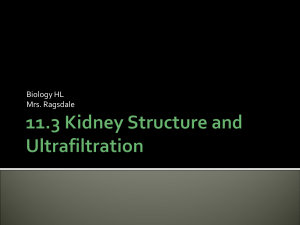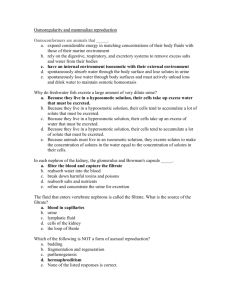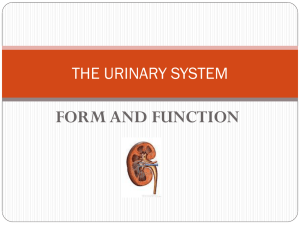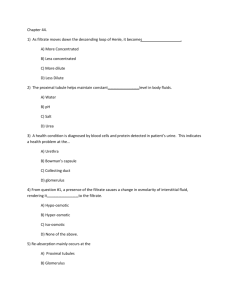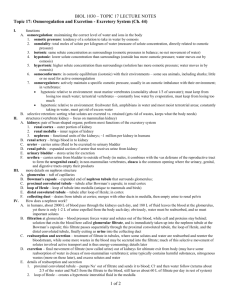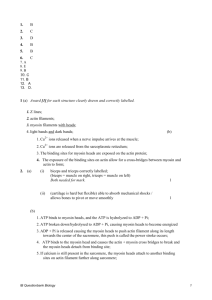Kidneynotes
advertisement
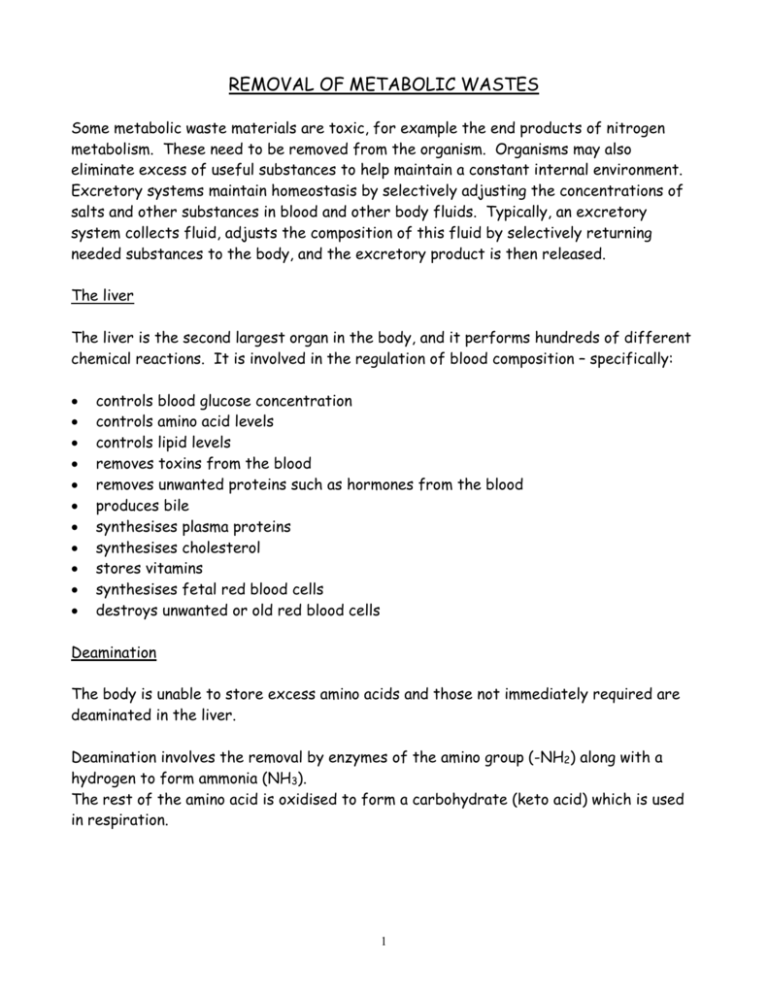
REMOVAL OF METABOLIC WASTES Some metabolic waste materials are toxic, for example the end products of nitrogen metabolism. These need to be removed from the organism. Organisms may also eliminate excess of useful substances to help maintain a constant internal environment. Excretory systems maintain homeostasis by selectively adjusting the concentrations of salts and other substances in blood and other body fluids. Typically, an excretory system collects fluid, adjusts the composition of this fluid by selectively returning needed substances to the body, and the excretory product is then released. The liver The liver is the second largest organ in the body, and it performs hundreds of different chemical reactions. It is involved in the regulation of blood composition – specifically: controls blood glucose concentration controls amino acid levels controls lipid levels removes toxins from the blood removes unwanted proteins such as hormones from the blood produces bile synthesises plasma proteins synthesises cholesterol stores vitamins synthesises fetal red blood cells destroys unwanted or old red blood cells Deamination The body is unable to store excess amino acids and those not immediately required are deaminated in the liver. Deamination involves the removal by enzymes of the amino group (-NH2) along with a hydrogen to form ammonia (NH3). The rest of the amino acid is oxidised to form a carbohydrate (keto acid) which is used in respiration. 1 excess amino acids H2O deamination aerobic respiration keto acid + -NH2 used respired CO2 production of organic bases ACGTU or or excreted converted nucleotide synthesis for nucleic acid formation to glycogen via CO2 ornithine cycle NH2 urea C O NH2 The ammonia may be: used to synthesise other amino acids in transamination used to make nitrogenous bases converted to urea to be excreted. The ammonia is converted to urea for excretion by a cycle of reactions called the ornithine cycle. See box 15.3 page 337 J + J. Note you are not expected to learn the details of this cycle. Amino acids deficient in the diet may be produced by the liver in a process called transamination. However not all amino acids can be synthesised by this method and these must be obtained in the diet, they are called essential amino acids. Transamination involves the enzyme controlled transfer of the amino group of one amino acid to a carbohydrate. The kidney The kidneys maintain the body fluid composition at a steady state in spite of changes in water and salt intake. 2 There are three basic principles of kidney function; 1. Ultrafiltration, the blood is filtered at high pressure. 2. Selective reabsorption, the useful parts of the filtrate are returned to the blood. 3. Secretion, further substances not required by the body are secreted into the filtrate. e.g. hydrogen ions, ammonium ions and potassium ions. The two kidneys are located on either side of the vertebral column. Human kidneys are 12cm long and 7cm wide. They are covered by a layer of fat and are loosely joined to the abdominal wall by connective tissue. When cut in section the kidney is seen to consist of an outer cortex which is dark red in colour, an inner medulla which is paler in colour and the pelvis of the ureter which is white. The pelvis is a collecting region for urine, which drains from 1000's of collecting ducts, located in the kidney pyramids. Urine passes from the ureter to the bladder and finally to the outside by means of the urethra. A human kidney contains at least a million kidney tubules (nephrons) each of which is connected to a collecting duct. The nephron is made up of six regions diagram of nephron structure 1. Malpighian body (Bowman's capsule and glomerulus) 2. proximal convoluted tubule 3. descending limb of the loop of Henle 4. ascending limb of the loop of Henle 5. distal convoluted tubule 6. collecting duct 3 1. The Malpighian body The Bowman's capsule encloses the glomerulus, a knot of about fifty parallel capillaries originating from a single afferent arteriole and rejoining a single efferent arteriole. The capillary walls are composed of endothelial (lining) cells with openings between them of diameter 50 - 100 nm. These cells are pressed up against a basement membrane which envelops each capillary and forms the only continuous structure separating the blood from the lumen of the Bowman's capsule. The inner layer of the Bowman's capsule is composed of cells called podocytes, so called because they have processes resembling feet which support the basement membrane. The gaps between these feet are about 25nm. The basement membrane is the actual filter through which the blood passes. See fig 15.14 Jones and Jones page 340 Ultrafiltration occurs at the Malpighian body and removes from the blood all substances with relative molecular mass less than 68000, to form the glomerular filtrate. The glomerular filtration rate is 125cm3 per minute. All the blood in the body passes through the kidney every 4-5 minutes. The route for substances forced out of the capillaries is through the gaps between the endothelial cells of the capillary, through the basement membrane and between the feet of the podocytes. Red and white cells, platelets and large proteins are too big to pass through the basement membrane and so remain in the capillary. The fluid which passes through is called the glomerular filtrate. The filtration pressure is the pressure which forces fluid out of the glomerulus. It is the result of a balance between the hydrostatic pressure of the glomerular blood (+9.6kPa) which pushes fluid through into the Bowman's capsule and the water potential of the blood (-2.5kPa) and the hydrostatic pressure of the glomerular filtrate(+2.4kPa), which oppose it. Work out the net filtration pressure moving fluid out of the tubule. ………………………………………………………………………………………………………………………………………………………………… 4 See Box 15.15 Jones and Jones page 341 The blood pressure in the glomerulus may be varied by altering the diameter of the afferent and efferent arterioles which are under hormonal and nervous control. Glomerular filtrate contains glucose, amino acids, ions, and water. White and red blood cells, platelets and plasma proteins are not found in the filtrate. There is 125cm3 of filtrate produced per minute in humans and if this were all removed as urine it would amount to 180 dm3 per day. About 1500cm3 of urine is actually produced. What does this suggest about the fate of most of the filtrate? ……………………………………………………………………………………………………………………………………………………………… The rest of the nephron is involved in selectively reabsorbing substances which are useful. Further waste substances may be actively secreted into the tubules from the surrounding blood capillaries. 2. Proximal convoluted tubule The walls of the proximal convoluted tubule are composed of a single layer of epithelial cells with extensive microvilli on the surface lining the tube. The outer membrane of the epithelial cell rests on a basement membrane and is invaginated to form a labyrinth of basal channels, in addition adjacent cells are separated by intercellular spaces. Fluid circulates through this area and links the cells of the proximal convoluted tubule with the surrounding network of capillaries. The cells contain numerous mitochondria near the basement membrane to supply ATP for the carrier proteins involved in active transport. Write down three ways in which the proximal convoluted tubule is well adapted for reabsorption of substances from the glomerular filtrate. (see diagram next page) ……………………………………………………………………………………………………………………………………………………………… ……………………………………………………………………………………………………………………………………………………………… ……………………………………………………………………………………………………………………………………………………………… 5 diagram of reabsorption in proximal convoluted tubule Over 80% of the glomerular filtrate is reabsorbed in the proximal convoluted tubule. (All glucose, amino acids, vitamins, hormones, sodium chloride and 65% of the water). The mitochondria provide ATP for the active transport of sodium ions out of the proximal cells into the tissue fluid that surrounds them. The sodium ions then diffuse into the blood and are transported away. This creates a situation in which the cells always have a lower concentration of sodium ions than the filtrate and so sodium ions diffuse into the cells from the filtrate. The route for sodium into the cells involves co-transporter proteins in the membrane. There are several different co-transporters, including glucose–sodium co-transporters. The glucose is carried against its concentration gradient through the membrane with the sodium. This is sometimes called indirect active transport because the active transport of sodium has resulted in the movement of glucose which would not occur by diffusion alone. See fig 15.16 page 342 Jones and Jones The removal of these substances from the filtrate increases the water potential of the filtrate so that water is drawn out of the filtrate by osmosis and follows the sodium and glucose into the capillaries. Small molecular mass proteins < 68 000 which entered the filtrate during ultrafiltration are removed by pinocytosis at the base of the microvilli. They are enclosed in pinocytic vesicles to which primary lysosomes are attached. Hydrolytic enzymes are released and the proteins are digested to amino acids which may then be used by the cell or passed on to the surrounding capillaries. 3 and 4. The loop of Henle diagram of loop of Henle The loop of Henle has a descending limb, which carries fluid downwards and an ascending limb, which carries fluid in the opposite direction i.e. upwards. 6 The flow of fluid is described as counter current. The loop of Henle operates a counter current mechanism which is able to establish an increasing concentration of sodium and chloride ions across the medulla of the kidney. The highest concentration is at the base of the loop and the lowest concentration at the top of the loop. There is therefore an osmotic gradient across the medulla. The ascending limb is impermeable to water and actively transports sodium and chloride ions out of the filtrate and into the surrounding tissue fluid. As the two limbs are so close to one another this creates a high concentration of salts around the descending limb. The descending limb is permeable to water and as the surrounding tissue fluid is concentrated, water moves out of the descending limb and into the tissue fluid. Sodium and chloride ions diffuse along their concentration gradient from the tissue fluid into the descending limb, so the concentration of filtrate is very high when it reaches the base of the loop. The longer the loop, the greater the concentration difference between the top and bottom can be. Animals that live in dry habitats tend to have very long loops of Henle and a thick medulla whereas animals living in watery habitats tend to have short loops of Henle and a thin medulla. At the base of the loop the sodium and chloride ions tend to move out of the filtrate and into the tissue fluid by diffusion because even though there is a high concentration of salt in the tissue fluid there is a higher concentration in the tubule. 7 As the fluid moves up the ascending limb it continues to lose sodium and chloride ions and becomes less concentrated. Active transport is needed to remove sodium and chloride ions against their concentration gradient. However at any level there is only a small difference in concentration between the ascending and descending limbs so the gradient against which active transport has to work is never very great. The collecting duct also passes through the medulla of the kidney. See fig 15.17 page 343 Jones and Jones The gradient of salt concentration in the medulla that is created by the loop of Henle allows water to be reabsorbed from the filtrate in the collecting duct. The more concentrated the tissue fluid the more water can be reabsorbed and the more concentrated the urine can be. Summary Permeable to ions? Permeable to water? movement of water movement of ions Descending limb Ascending limb 5. Distal convoluted tubule The cells of the distal tubule have brush borders and abundant mitochondria and this region is the site of the mechanisms for the fine control of salt, water and pH balance of the blood. 6. The collecting duct The collecting duct and distal convoluted tubule are involved in the control of water content of the blood. The permeability of their walls is controlled by anti-diuretic hormone, ADH. The solute potential of the blood is maintained at a constant level by balancing water lost in evaporation, sweating, egestion and urine with that taken in with the diet and produced in respiration. A rise in blood solute potential is detected by osmoreceptors in 8 the hypothalamus. Nerve impulses pass to the posterior pituitary gland where ADH is released into the blood. ADH increases the permeability of the distal tubule and the collecting duct, water passes from the filtrate into the tissue fluid of the medulla and then into the blood. ADH also increases the permeability of the collecting duct to urea, which increases the osmotic concentration in the tissue fluid of the medulla resulting in the removal of an increased volume of water. diagram of effect of ADH If the solute potential of the blood rises ADH release is inhibited and the walls of the distal tubule and the collecting duct become impermeable to water, less water is reabsorbed as the filtrate passes through the medulla and a large volume of dilute urine is excreted. This regulation of the water content of the body is called osmoregulation. Complete the flow chart to show the effect of ADH on this process Body’s solute potential normal Increased water intake Decreased water intake 9
